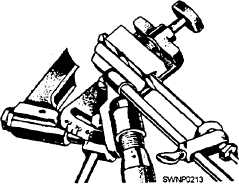An attachment for conventional tool grinders is shown in figure 12-27. In a shop where a high degree of hole accuracy is required and a large amount of sharpening is to be done, a machine or attachment is a must.
A compressor is a machine for compressing air from an initial intake pressure to a higher exhaust pressure through reduction in volume. A compressor consists of a driving unit, a compressor unit, and accessory equipment. The driving unit provides power to operate the compressor and may be a gasoline or diesel engine. Compressors are governed by a pressure control system adjusted to compress air to a maximum pressure of 100 psi.
Compressed Air System
A compressed air system consists of one or more compressors, each with the necessary power source, control of regulation, intake air filter, aftercooler, air receiver, and connecting piping, together with a distribution system to carry the air to points of use.
The object of installing a compressed air system is to provide sufficient air at the work area at pressures adequate for efficient operation of pneumatic tools being used.
Many construction projects require more cubic feet of air per minute than any one compressor will produce. Terrain conditions often create problems of distance from the compressor to the operating tool. Since the air line hose issued with the compressor causes considerable line loss at distances farther than 200 feet, a system has been devised for efficient

Figure 12-27.-A drill bit sharpening attachment mounted on a conventional bench grinder.
transmission of compressed air over longer distances. This system is called air manifolding (fig. 12-28). An air manifold is a pipe having a large diameter used to transport compressed air from one or more compressors over a distance without detrimental friction line loss. In construction work, air manifolds are usually constructed of 6-inch diameter pipe. A pipe of this size can carry 1,200 cubic feet per minute (cfm) of air (output from two 600 cfm air compressors) at 100 psi with less than .035 pound pressure loss per 100 linear feet. One or more compressors pump air into the manifold and eventually "pressurize" it at 100 psi; then air may be used at any point along the manifold by installing outlet valves and connecting air lines and pneumatic tools.
Compressor Operation and Maintenance
The following paragraphs will give generaI instructions on operating and maintaining air compressor units.
A compressor must be located on a reasonably level area. Most compressors permit a 15-degree lengthwise and a 15-degree sidewise limit on out-of-level operation. The limits are placed on the engine, not the actual compressor. When the unit is to be operated out-of-level, it is important to do the following: (1) keep the engine crankcase oil level near the high-level mark (with the unit level) and (2) have the compressor oil gauge show nearly full (with the unit on the level).
An instruction plate, similar to the one shown in figure 12-29, is attached to all compressors. Notice that this plate refers you to the manufacturer's engine and compressor manuals for detailed instructions.
STARTING THE UNIT.-Take the following steps when starting the engine during mild weather:

Figure 12-28.-Methods of manifolding compressors.
Continue Reading